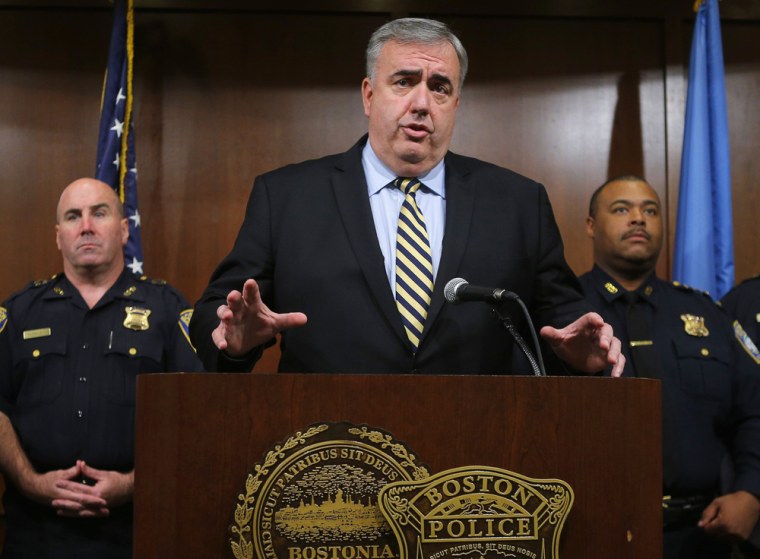PHILADELPHIA -- Six months after the Boston Marathon bombing, Police Commissioner Ed Davis described the attack as “still surreal” on Tuesday after watching a video of the terrorist attack at a gathering of international law enforcement officials.
Davis, addressing the annual conference of the International Association of Chiefs of Police, said significant security preparations that preceded the marathon were not sufficient to stop an attack by two terrorists who had no ties to international organized terrorists groups.
More than 10 years after the Sept. 11 terrorist attacks, Davis said the attack serves as a reminder that the threat of terrorism persists, but today often wears a different guise.
Wearing a blue suit and a white shirt, Davis, shared the stage with officials from the Cambridge police, Massachusetts state police, transit police, Boston FBI office and other agencies involved in the response to the marathon bombing and subsequent manhunt for the perpetrators.
Davis, who has previously said he intends to retire after Boston’s mayoral election in November, also indicated that he may be accelerating that timetable, saying he was pleased to be able to speak to his peers in “what is probably my last week in policing.”
He recalled watching the press begin to leave on April 15 after the first runners crossed the finish line and the sense of relief that came with the lifting of the international spotlight. Then at 2:48 p.m., the first bomb went off.
“The bomb was very powerful,” Davis said. The second blast occurred about 500 feet away. At that point police officers halted the runners, and Davis took a call.
“Boss, I don't know what happened, we had two explosions,” Davis recalled being told. He said he suggested it could be manhole explosions. But his officer replied he didn’t think so because they were getting calls for all available ambulances.
Davis said he immediately called the FBI and asked for their SWAT assets and their EOD (bomb disposal) experts.
Within minutes, the 843 officers assigned to the race were joined by dozens of others.
Davis began to hear of the amputations, and recalled thinking it must have been explosives placed close to the ground that caused the numerous lower limb injuries.
As a makeshift morgue was set up, and officers began a methodical search for more bombs, a large multi-block area of downtown Boston was established as the perimeter of the crime scene. Officers also began to move numerous patients with tourniquets applied to their lower limbs to area hospitals. Those tourniquets among the more than 250 injured prevented a greater loss of life, he said.
Over the course of seven days evidence teams collected every shard of shrapnel, Davis recalled, even as the manhunt for the suspects – and Chechen immigrants Tamerlan and Dzhokar Tsarnaev -- was underway, aided by photographs and video recorded at the scene.
“A lot of these photographs were crowd sourced,” Davis noted, crediting public Information officer Cheryl Fiandaca with putting out an early request for information to the public. “... There was an incredible sense of urgency.”
He said that within 24 hours of identifying the suspect, photos of the Tsarnaev brothers were released to the public. Soon reports began to come in that indicated the suspects were on the move.
“We're chasing these suspects in Watertown right now,” one officer told Davis. “They're shooting at us and throwing bombs.” GPS enabled the officers to track the car. They caught it and a “fierce firefight' ensued.
Watertown's police chief, Edward Deveau, praised the first three officers who caught up with the suspects calling them “true American heroes who stood up for our country.”
The crowd burst into a standing ovation as Davis praised these officers and recounted the officers wounded during the manhunt.
“One suspect (Tamerlan Tsarnaev) ran out of ammunition,” Davis said, then the suspect’s brother ran over him with a car even as an officer tried to cuff him. “He was still alive when we transported him to the hospital.” (Tamerlan Tsarnaev died of his injuries; Dzhokar Tsarnaev, who was wounded before being recaptured, has been charged with use of weapons of mass destruction resulting in death, and could face the death penalty if convicted. He has pleaded not guilty.)
Davis spoke clearly and recounted the incident in his powerful voice, his emotion reserved for when praise was given for the officers wounded and those who gave their lives, including the MIT officer who was the first slain.
Davis noted that “misinformation among our colleagues in the media was running rampant.” Davis added that the 24 hour news cycle added to the “fog of war.”
Davis showed a photo of a packed press briefing. “This is not a place you want to be,” he recalled. But the dialogue directly with the community was aided by social media, he said.
“”The terrorists,” he said, “attempted to turn us into a dysfunctional city. ... They failed.”
More from NBC News Investigations:
- http://investigations.nbcnews.com/_news/2013/10/22/21065224-will-i-be-next-rights-groups-say-us-drone-strikes-violate-law?lite ">'Will I be next?' Rights groups say US drone strikes violate law
- CeeLo Green cleared of sex assault, charged with giving drugs to woman
- How millions of violent Muslim deaths feed the cycle of terrorism
